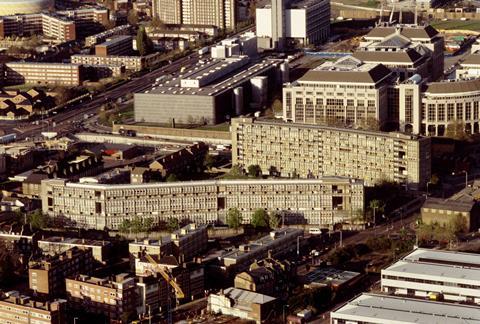Museum salvages three-storey fragment of architectural history

The V&A has bought a three-storey section of Robin Hood Gardens before the seminal Smithsons’ project is demolished.
The museum acquired the fragment on the suggestion of Liza Fior, founder of architecture practice muf, when she was completing a residency at the V&A.
The piece is 8.8m high, 5.5m wide, 8m deep and includes interiors as well as the front and back facades and a section of “street in the sky”.
The museum’s curator of contemporary architectural collections, Neil Bingham, said it wanted to preserve for future generations a relic of an important building in the history of the development of modernism into brutalism designed by the profession’s leading intellectuals of their day.
It was also interested in the almost unprecedented campaign to save the 252-flat estate, which was led by the Twentieth Century Society and Building Design with support from leading figures in the profession such as Richard Rogers and Zaha Hadid.

The two curved slab blocks and the central grassed hill, built from the rubble of the Victorian terraces which once stood on the site, are making way for towers containing 1,500 flats.
Robin Hood Gardens was built by the Greater London Council (GLC) in 1972 and later transferred to Tower Hamlets. The choice of Alison and Peter Smithson as architects gave the wife and husband team their only opportunity to create a council estate. Robin Hood Gardens was the culmination of their research on and vision for social housing. It is distinctive for its noise-reducing features, like exterior concrete fins, and for its elevated walkways, known as streets in the sky, intended to foster interaction between neighbours. It was turned down for listing in 2015.
Bingham said: “Robin Hood Gardens is an internationally recognised building by Alison and Peter Smithson, the protagonists and intellectual leaders of the Brutalist movement. When demolition of their social housing project was imminent, Liza Fior, who was at the end of her year-long residency at the V&A, proposed that the museum should collect a fragment of the building and worked with us to help secure it. The V&A’s acquisition of a section of Robin Hood Gardens, complete with front and back facades, will motivate new thinking and research into this highly experimental period of British architectural and urban history.”
Dr Christopher Turner, keeper of the design, architecture and digital department, said: “It is also an object that will stimulate debate around architecture and urbanism today – it raises important questions about the history and future of housing in Britain, and what we want from our cities.”
The museum already owns large pieces of London architecture, including the 17th-century timber facade of Sir Paul Pindar’s House in Bishopsgate and the gilded music room salvaged from Norfolk House in St James’s Square.
Catherine Croft, director of the Twentieth Century Society which helped spearhead the campaign to save the estate, described the news as “bittersweet”.
She said: “It is very prescient of the V&A to recognise the significance of the estate, both as an example of high modernist design, and as a highly controversial conservation disaster. We are sure that future generations will be inspired by the exhibit, and be as incredulous that demolition of RHG was allowed as we are today about the destruction of the Euston Arch.
“RHG is an outstanding example of post-war public housing, which the Twentieth Century Society fought long and hard to get listed and to save. It could have been refurbished to provide good quality housing. We deeply regret its demolition which finally commenced this autumn. Keeping a small section is by no means an adequate way of preserving all that is important about a great building, but nevertheless we are delighted that some sense of the physical materiality of RHG will endure.”













6 Readers' comments